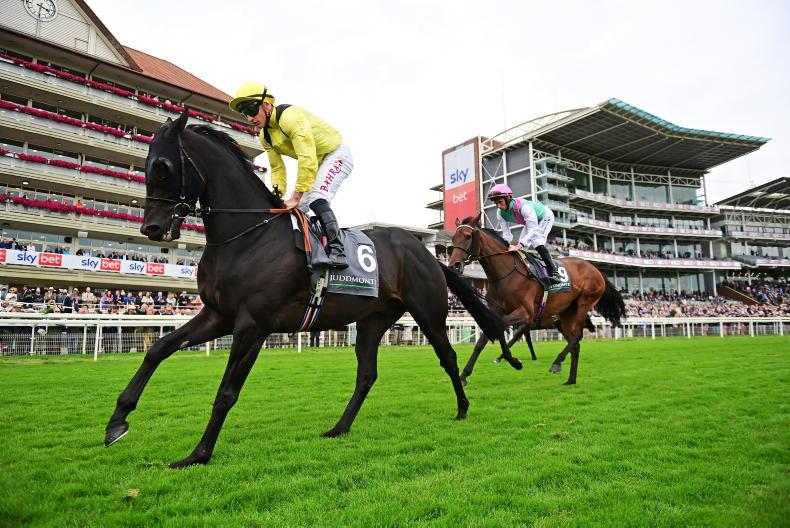NOT many consignors could confidently say they had a thoroughly successful time at this year’s yearling sales, given the ups and downs of trade.One that stood out, though, was John Foley’s Ballyvolane Stud, who achieved impressive results with a mixture of home-breds and pinhooks.
I’ve listed two of the results as highlights in my overall pinhooking review, a Calyx colt bought for €23,000 and resold for €220,000, and a Gleneagles colt bought for €28,000 and resold for 280,000gns. It made me wonder if Foley sets out to buy foals by proven sires, but he assures me it wasn’t by design.
“I promise you, I don’t set out to buy a proven horse,” he says. “I look at as many foals as I can possibly physically do on my own in a day. I get through as many as I can, because there are touches to be got at every sale, whether it be Goffs or Newmarket, it doesn’t really make a difference. The horses are there, you just have to find them.”
There was one specific foal he was looking for though, he admits. “Last year, I kind of had an idea that I wanted to buy a Gleneagles. I don’t know why, but I just thought he was an underrated and an undervalued stallion. There were two on the Saturday in Goffs. There was one we bought and there was another that the Armstrongs [Beechvale Stud] bought and they got a right touch for that as well.”
Ballyvolane Stud’s best results were achieved at the Orby Sale, Book 2 and Book 1, his only offering at the latter sold for 400,000gns, having cost 85,000gns. Concentrating on certain yearling sales is a must for Foley, he explains.
“I just find it hard being away from home for so long. If you go to every sale, you’re missing about five weeks of prep for your most important horses. I’ve got good lads at home, and I trust them, but I’m hands on, and I want to be there.”
As for where to send what horse, the formula was simple. “We had kind of a solid bunch of what you would call nice Book 2 horses. I can’t have 14 in Book 2, myself. Plenty of people do manage it - they’d have a yard full of them and do a very good job selling them, but I just don’t think I can do it.
“I like to keep my Book 2 draft at around eight to 10, or something like that. Then we kind of divide the stallions. There’s no great method in it, you just choose the sale to suit the horse, with the view of who might buy it there.”
Past, present & future
So, is there a plan in place for the 2024 foal sales? “I’d love to say I’ve a strategy in place of exactly how I’m going to do it, but you just look at as many as you can, and buy them as good as you can, as cheap as you can.”
Foley’s background, as well as his success, should inspire any aspiring pinhooker that didn’t grow up in the industry. “My mum’s a retired physio and my dad had a timber importing business, with no connection to horses. We did a bit of riding when we were younger, and we did hunting and stuff like that.
“When I was in college, I went to ride out for Enda Bolger, and then I went to America on a J1 and worked in Ashford Stud for the summer. That was the first time I touched a flat thoroughbred.
“There was a good crowd in America that year - Mike Doyle, Roger O’Callaghan, Mick Fitzpatrick, Barry Mahon, Tom Ryan, who’s still in America, we were all there at the same time. I was in very good company, as it turns out.
“When I came home, I finished college - I did International Business and French in college, and did a summer in Yeomanstown Stud before I bought my first two foals. I think that was 19 or 20 years ago, and built it up very slowly ever since.”

It hasn’t all be plain sailing, though, and throughout our chat, Foley is keen to emphasise how aware he is that next year’s sales could produce far lesser results for his operation. “Believe me, there were a lot of hard lessons learnt along the way. You deal with disappointment so much of the time. The most important thing, what we all want, is good racehorses.
“You need them to sell well, because you’ve got a business to run, and a farm to pay for, you need the money to keep the thing going. But we’re all after the same thing and that’s good racehorses. They are your biggest adverts, and they’re what get people back.”
Among the best horses Foley has dealt with is dual group winner and multiple Group 1-placed Cayenne Pepper, who he bred in partnership with Michael Fitzpatrick. The same pair pinhooked Group 2 winner Maljoom, who placed in two Group 1s, while Foley himself bred Group 2 scorer Sir Busker.
“We’re going pretty good, we seem to have a blacktype horse every year. Good horses are the most important part, I can’t emphasise that enough.
“There’s no getting away from the amount of luck that’s involved as well, there’s a huge amount of luck involved.”